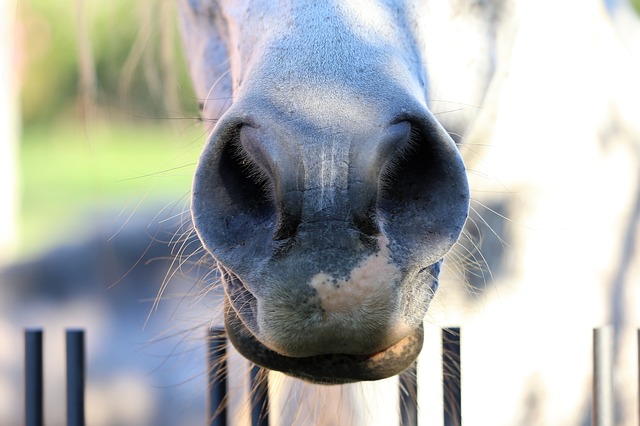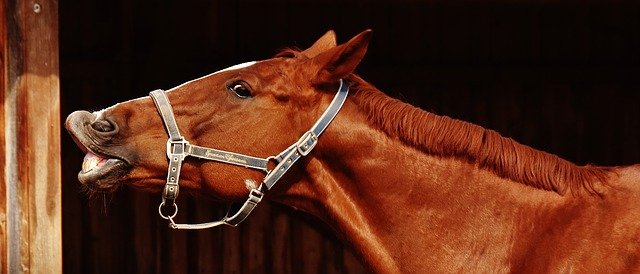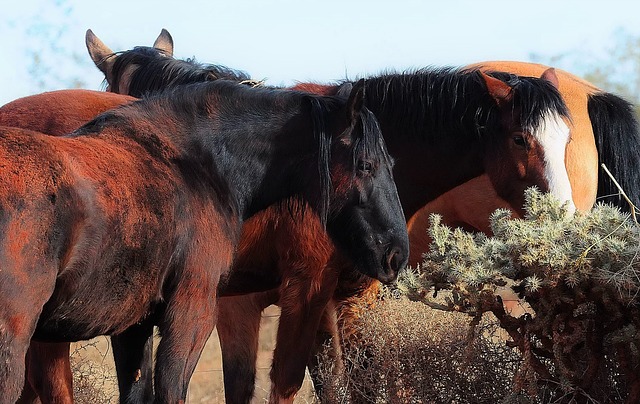Horses are very curious and seem to love new things.
For a prey animal, this is an interesting trait, but it’s also a helpful natural behavior. Wild horses may sometimes run from a new and frightening situation, but are just as likely to explore and gather more information before deciding what to do.
When your horse is curious about something, they use their senses to gather information as quickly as possible in order to make a decision about whether the new situation is safe, unsafe, or possibly rewarding. From there, they’ll choose whether to investigate further, using some specific patterns of behavior. Wild horses encounter new items, views, and experiences on a daily basis, so their investigative behaviors are important. Your domestic equine – horse, donkey, and everything in between – can benefit from regular enrichment that allows them to explore and show curiosity about their environment. It’s not only important for keeping them occupied and relieving boredom; encouraging curiosity can make your horse more confident and comfortable in its environment and during riding.
Any new or changing situation can trigger curiosity, and your horse may want to investigate seemingly boring situations. They may show interest in new people or animals around their environment, enjoy investigating new objects or equipment, or become very interested in something that smells unusual. Here’s how your
Sensing Something New
Horses become curious when they encounter something new or different using their senses. Because horses are naturally prey animals, they are always observant of their surroundings, even when they seem to be resting or focused on eating. They may become aware of an approaching item, person, or situation using their hearing or sense of smell long before they can see the new situation. If they’re traveling in the pasture or on a walk or ride with a person, they’ll be exploring with their eyes as well.
Sensing a change in their environment causes your horse to become more alert, displaying more attentive behavior. They’ll swivel their ears toward the new situation and may turn to look at it with both eyes.
We often overlook the sense of smell because ours isn’t so great compared to other animals. But horses have a great sense of smell, and when your horse is curious about something, you might see their nostrils flaring or changing shape as they gather more information using their sensitive noses.

To Spook or Not to Spook?
This initial information-gathering can take place very fast. Your horse will then decide whether to investigate further, or whether the situation should be avoided. When a new situation happens fast, your horse’s instincts for safety might kick in, causing a startle or spook as they reflexively try to get distance from a potentially dangerous object.
Most changes or new experiences don’t trigger spooking, though you may know or own horses who are more prone to this behavior than others. If your horse does seem to spook at everything and this seems to be affecting their quality of life (and making fun enrichment harder or impossible), it’s important to talk to a vet. There are many physical causes for inappropriate startling or fear reactions.
When giving horses enrichment, fear and spooking are rare. These are natural behaviors that help keep horses safe and don’t show up frequently when we use enrichment like toys and food puzzles.
A Closer Look
Most of the time, horses will explore a new object or opportunity on their own to figure out their next response. After all, new objects could be tasty, smell good, or be great for self-grooming or even play! To get more information about whatever they’re curious about, your horse will get closer, walking (or even trotting) up to the interesting object. This is why novel objects and sensory experiences can be great ways to encourage more movement and exercise for your equine friends.
Unless your horse shows nervousness or even neophobia (fear of new things), they’ll investigate closely. A close inspection of the interesting thing can involve all their senses. When they’re close enough to touch the item, your horse will use their sensitive whiskers to get more information, and even reach out and touch or paw with a hoof to see what the object does.

What To Do About It?
When your horse feels like they’ve gotten enough information about a new situation or object, they make a last decision: what to do about it. If you watch your horse at this stage, you’ll see different behaviors depending on the situation. Sometimes a new object doesn’t need further attention, and the horses will wander off to do other things. A new object or toy might smell or look edible, and you’ll see your horse use food-seeking behaviors. A new animal or horse might cause your horse to show social behaviors and interesting body language such as play, appeasement, or aggression. Even a simple change in the environment can promote curiosity and lead your horse to use their space in a different way.

Think about how many different ways your horse could react to a situation after they become curious and explore. There’s a huge number of different things a horse can choose to do! Those behaviors and the freedom to choose help keep your horse occupied, free from boredom, and mentally stimulated.
Big Opinions and Different Reactions
Letting your horse experience variety and express curiosity gives you a window into how they feel about different situations. You’ll see lots of facial expressions as your horse shows curiosity, including interest, excitement, and sometimes even anger and nervousness. Some horses seem to clearly enjoy exploring and investigating. They approach new objects with clear intent, have an open and relaxed facial expression, and get right to the business of discovering what the new experience means for them.
Other horses prefer to show a little bit of curiosity, but may choose to keep more distance from the change or new experience. This is a normal equine behavior, too. Just like people, some horses are more reserved, prefer to let others act first, or don’t get as interested in some situations as other horses.
A few horses display overt fear or anger when given the opportunity to explore. This is rare, but it can happen. Getting to the bottom of why a horse shows curiosity followed by panic or aggression can help you understand what your horse is doing and how to help them enjoy new experiences.
Increasing Your Horse’s Curiosity
Hesitation to explore or be curious can come from a horse’s prior history or lack of experience with novelty. Exploration and curiosity are behaviors that need practice too! If a horse has had a bad experience with an item or situation, it’s understandable for them to avoid similar experiences. This can add up over time until a horse seems to have no natural curiosity at all…or responds with panic or aggression.
If your horse becomes extremely fearful in situations that would bring out curiosity in others, take a look at how the environment was set up for the horse. Is the new situation too close for comfort, preventing the horse from investigating at their own pace? New situations – enrichment or just life experiences – should happen gradually if possible, or take place at a distance from the horse.
Is your horse free to explore and show curiosity? Giving them the chance to investigate new enrichment opportunities without a halter and lead is preferable from a confident standpoint. Wearing a halter usually means “Time to work and focus!” to many horses, who may expect to be corrected or punished if they try to explore and investigate. If the environment or interesting object is safe, try letting your horse explore at liberty instead.
Use enrichment as a way to encourage curiosity. New and special feeding opportunities and other enrichment items not only encourage natural behaviors, they teach your horse that new items are fun and rewarding. An enrichment routine that includes both favorite, known items and new enrichment is the best way to keep your horse curious and engaged.
Get Curious!
Here’s a recap of equine exploration and how it fits into your horse’s behavior and care plan.
- Horses investigate new and changing situations using all their senses.
- Your horse will use different senses depending on what they’re curious about and how far away it is.
- Exploration and investigation gives your horse information and lets them decide whether a new experience is safe, dangerous, or worth their time.
- A regular enrichment routine with lots of toys, feeding opportunities, and other behavioral care helps foster curiosity.
- The way you present enrichment can help a nervous or disengaged horse explore successfully.
There’s no limit to the different kinds of curiosity-promoting experiences we can give our equine friends. Exploration and investigation are behaviors with lots of benefits! Are you ready to encourage your horse’s curiosity? Try the following enrichment experiences:
- Adding one or two new toys each week to your horse’s toy lineup
- Changing the position of moveable pasture objects like water troughs and feeders
- Giving your horse a new and unfamiliar object to explore once per week (you can use anything as long as it’s horse-safe!)
- Putting your horse’s daily feed in a brand-new container
- Adding a new flavor to your horse’s feed, like vanilla or mint
By promoting equine curiosity, you’ll help your horse become more brave and accepting of new situations. Enrichment that encourages investigation is a win for both you and your horse!
